Germany’s V-2 ballistic missile was one of the most remarkable weapons of WWII, years ahead of it’s time. After the war, the US Army and civilian agencies fired captured examples for research, both military and scientific. Less well-known is that the US Navy fired one example off an aircraft carrier.

(A V-2 missile being launched by German forces during WWII, and aboard USS Midway after the war.)
The USA’s 1945 operation “Paperclip” was one of the most successful intelligence operations of all time, securing nearly the entirety of Germany’s V-2’s scientists in the closing days and hours of WWII in Europe. As part of “Paperclip”, one hundred V-2 missiles were captured in May 1945, along with spare parts, transport trailers, and technical manuals. These were first collected in the USA’s occupation zone of Germany and then moved to White Sands, NM where they formed the core of both the first American postwar missiles and NASA’s foundation for manned space flight.

(Captured V-2 missile at White Sands, NM after WWII.)
After WWII, the US Navy began to consider the feasibility of firing a ballistic missile off a ship. This concept was not new, as during WWII Germany had made plans for towing a V-2 encased in a 500-ton watertight canister behind a u-boat, so that the missiles could be used against the USA. The Germans tested a prototype container in the Baltic, but WWII ended before the project could be further developed and there were serious doubts if a ballistic missile could be launched at sea at all.
Operation “Sandy” was led by Rear Admiral Daniel V. Gallery, who will be forever remembered in the USA as the leader of the WWII task force which captured U-505 on the high seas during WWII. After the capture of the submarine, Gallery was promoted and made captain of the aircraft carrier USS Hancock (CV-19) in the Pacific.
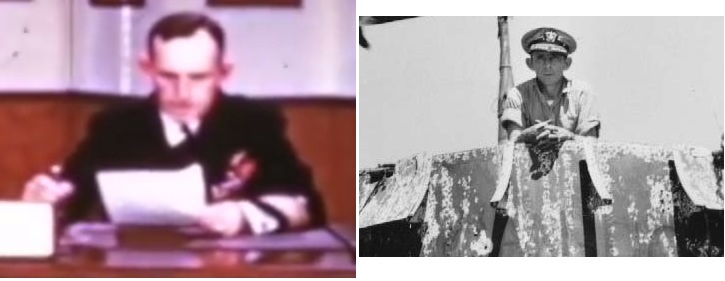
(Rear Admiral Daniel Gallery during the planning of operation “Sandy”, and still as a Captain aboard the captured U-505 during WWII.)
After the end of WWII, the Commander of Naval Operations, Fleet Admiral Chester Nimitz, recognized that Gallery (obviously) had a knack for thinking unconventionally in terms of naval warfare, and also that he was a very no-nonsense, straightforward man. Gallery was made a Special Assistant to the CNO, in charge of unusual projects and technology, of which the German V-2 missile definitely was. Gallery was a good fit for organizing a ballistic missile launch off a carrier, as he was interested in rocketry, had commanded an aircraft carrier, and worked well with US Army officers.
This would be the first time ever that a long-range ballistic missile would be fired off a warship, and the first time a V-2 would be fired from a moving object.
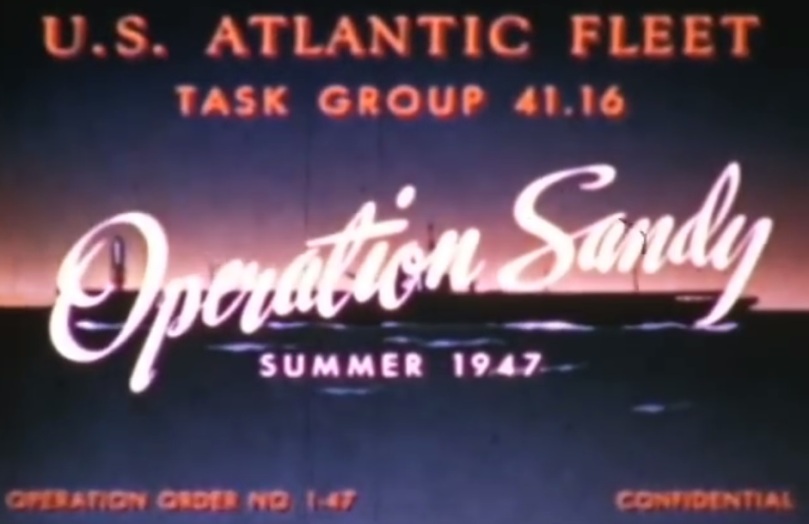
The purpose of operation “Sandy” was to prove the feasibility of launching a ballistic missile off a ship, and to gain experience in what requirements such an operation would entail. The secondary goal was to test the ability of sensors to detect and track a ballistic missile launched from the sea.
The US Navy never had any intentions of using WWII captured V-2s as actual weapons, nor was there any intention of directly copying the German design. (This contrasted with the USSR, which produced a postwar copy, the SS-1 “Scunner”.) There was never any intention of fitting a nuclear warhead, as the Manhattan Project-era Mk2 Little Boy and Mk3 Fat Man were too large, as were the first postwar nuclear bombs, the Mk4 and Mk5. There was no intention of using conventional warheads as the damage caused would not be worth the expense. Operation “Sandy”, and the American postwar V-2 effort overall, was simply using the WWII German missiles for research and tests.
The V-2 itself
The V-2 (or it’s formal WWII German designation, A-4) was the world’s first successful ballistic missile. It weighed 13¾ tons and was 45’11” long. It was guided by two gyroscopes and carried a 2,200 lbs HE warhead, with a maximum range of about 200 to 220 miles.
The V-2 was liquid-fueled. The propellant portion was a German chemical known as B-Stoff, which was mainly ethyl alcohol diluted down to 74%. The oxidizer portion was liquid oxygen (LOX). Both were extremely flammable in their own right, and together in the presence of an ignition produced a tremendous reaction. The two portions were stored in separate tanks in the V-2’s fuselage, and pumped into the rocket engine’s combustion chamber where they ignited. To force the two together, a 500hp pump was needed. No pumps of the era were up to the task so a turbine was used, sort of an ‘engine-in-an-engine’, powered by hydrogen peroxide (itself dangerous) reacting with sodium permanganate.
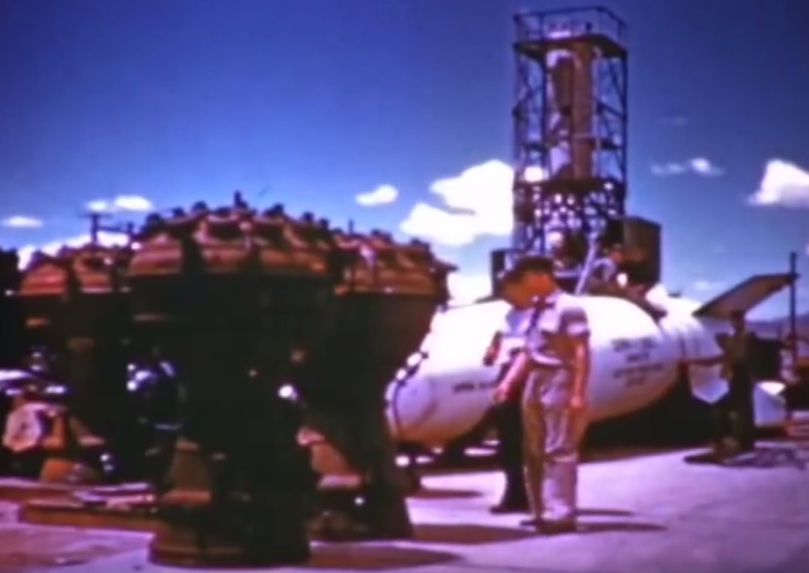
(Three loose engines and a captured V-2 at White Sands, NM after WWII.)
The V-2 was steered by four solid carbon vanes in the rocket’s exhaust stream at launch, until enough airspeed was attained that the fins could take over. The missile flew under power for about 65 seconds.
USS Midway
Rear Admiral Gallery selected USS Midway (CV-41) for operation “Sandy”. This 972′-long, 45,000 ton carrier, the leadship of her class, was at the time the most powerful aircraft carrier ever designed. After the sinking of IJN Yamato in 1945, USS Midway was the largest warship of any type on Earth. USS Midway was launched on 20 March 1945 and was completing sea trials in the Atlantic when Japan surrendered. USS Midway commissioned on 10 September 1945, eight days after the end of WWII.
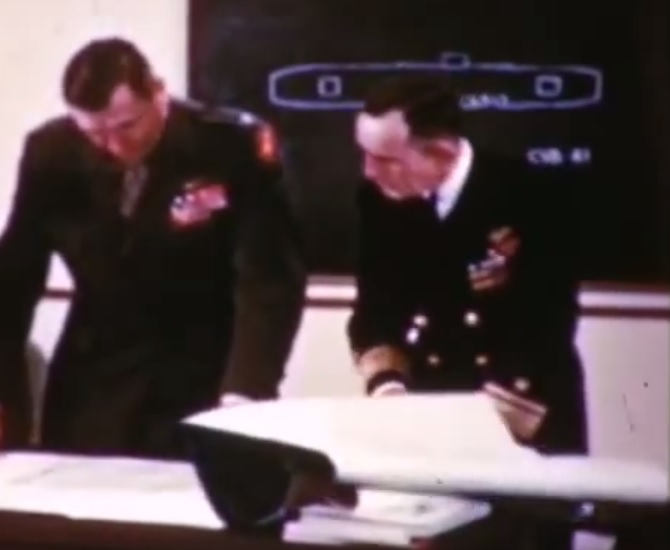
(A US Army officer and Rear Admiral Gallery study blueprints of USS Midway prior to operation “Sandy”.)
Besides the design’s huge size, the Midway class was ideal for operation “Sandy” as this was the first American carrier design with a steel flight deck. Previously, the flight deck on American carriers was a freestanding structure of wooden planks, with the hangar deck considered the “top” of the hull. On USS Midway, the flight deck was 3½” hardened steel.
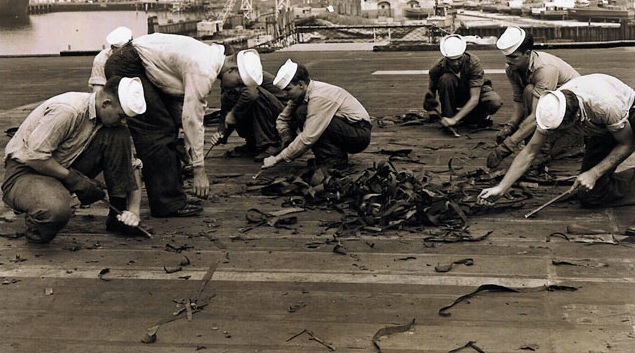
(Sailors scrape the antiskid coating off the section of USS Midway’s steel flight deck which would be directly under the German missile when it was launched.)
For operation “Sandy”, the missile would be fired from the extreme stern end of USS Midway‘s flight deck, to minimize the danger to the carrier’s island if something went wrong.
Operation “Sandy”
Initial training on the V-2 and it’s German support systems was given to US Navy sailors by the US Army Ordnance Department at White Sands, NM.
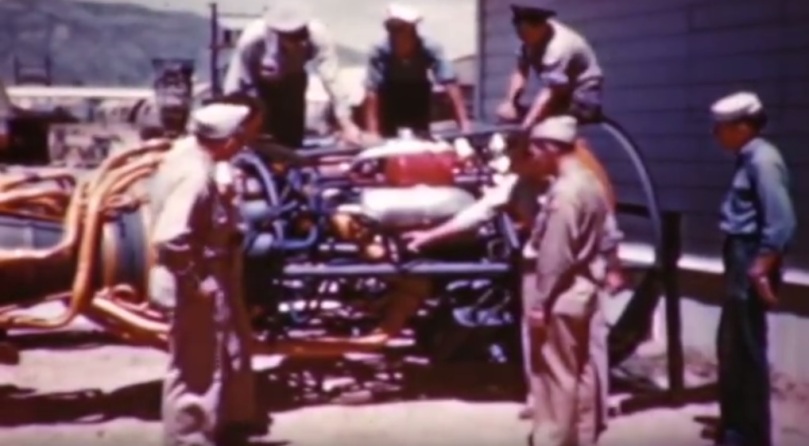
(US Army soldiers explain the internal details of the V-2’s propulsion section to US Navy sailors at White Sands, NM.)

(US Navy personnel examine the guidance fins of a V-2 at White Sands.)
Three captured V-2 missiles were provided by the US Army. One was the primary missile, the second a backup in case the primary was accidentally damaged aboard ship, and the third a non-flightworthy dummy for training use. The three V-2s and associated equipment were shipped via railroad from New Mexico to Virginia and collected at Naval Base Norfolk, VA. They were loaded aboard USS Midway there.
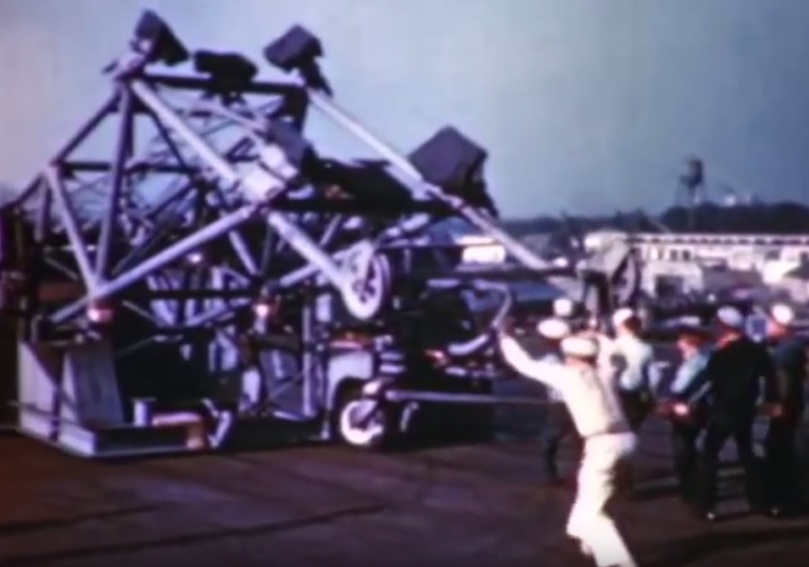
(A section of the launch gantry being prepared for loading onto USS Midway.)
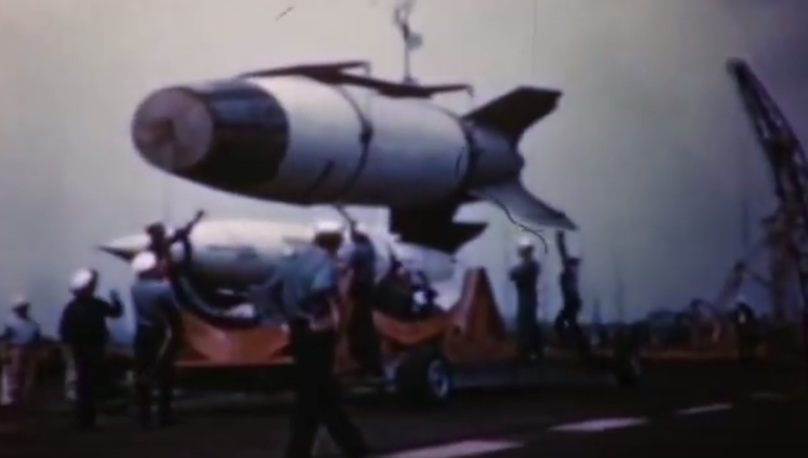
(The backup V-2 being craned aboard USS Midway in Norfolk.)
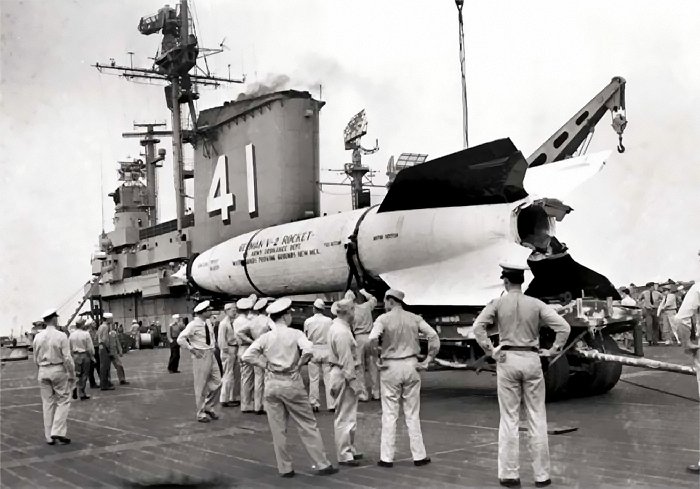
(The dummy V-2 after being loaded aboard USS Midway in Norfolk.)
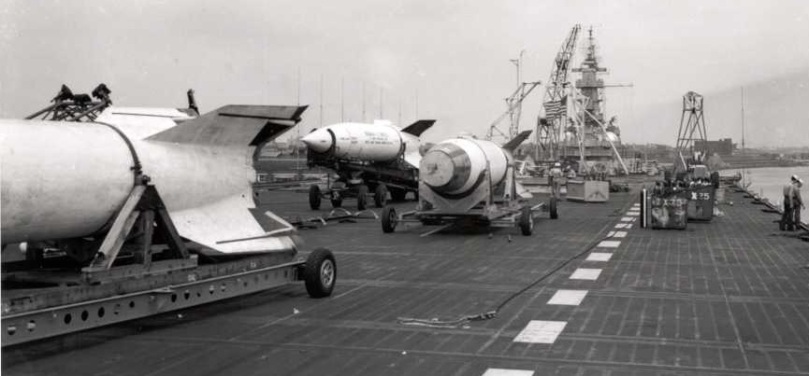
(All three V-2 missiles aboard USS Midway. The one in front was the primary, the one with no nose ballast the backup, and finally the dummy behind it.)
The warheads and fuzes were removed and replaced by ballast. One modification was that the bottom of the V-2’s fins were strengthened to prevent crumpling between 3°-5° off the vertical axis; this was done in case USS Midway happened to take a wave at the exact moment of launch.
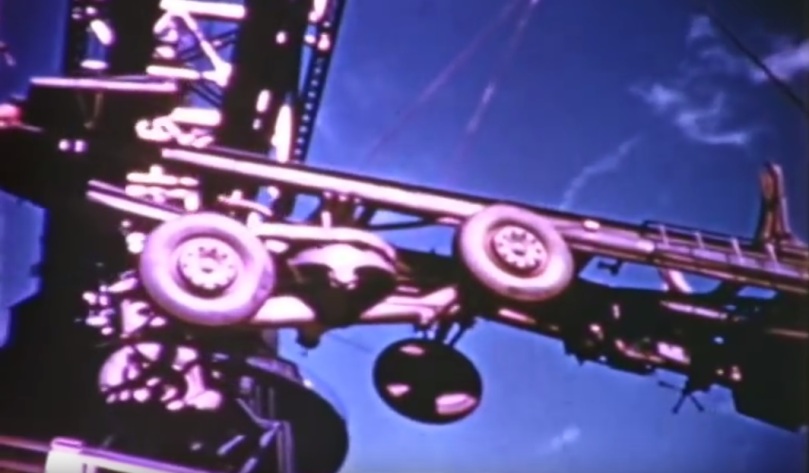
(A captured WWII Wehrmacht Meillerwagen being hoisted aboard USS Midway in Norfolk. The Meillerwagen was the transporter/erector for the V-2 and towed behind a truck or halftrack during WWII. It was well-designed and durable, and the USA used captured Meillerwagens throughout it’s post-WWII V-2 test program.)
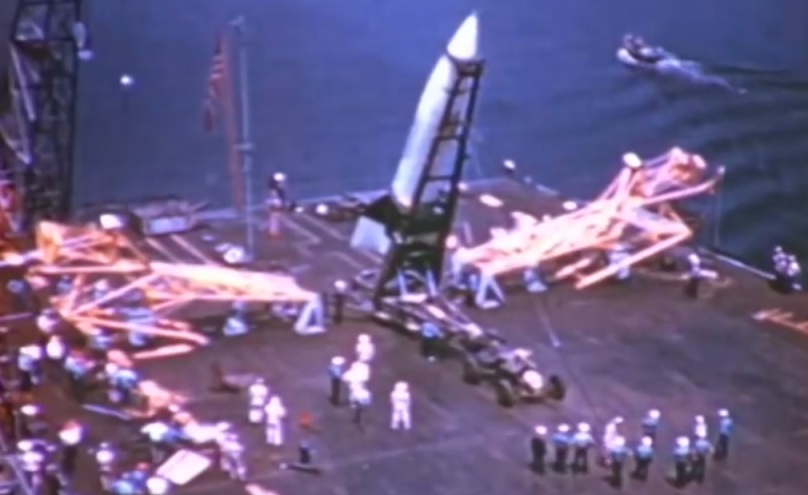
(The Meillerwagen aboard USS Midway erecting the V-2 onto the Brennstand launching platform, during training while the carrier was still in Norfolk.)
Two types of shipboard launching gantries were designed by the US Navy, one by the Bureau of Aeronautics and the other by the Bureau of Ordnance. This type of cross-bureau duplication was not uncommon in the earliest years of ballistic missiles; as it was unclear if ballistic missiles should be considered “aircraft” or “ammunition”.
The Bureau of Ordnance gantry weighed 68 tons while the Bureau of Aeronautics design weighed 7½ tons. Both were tested at Naval Base Norfolk prior to USS Midway getting underway. Both performed well. The Bureau of Aeronautics version was eventually selected simply because it was lighter. While USS Midway was still inport, the “Sandy” gantry team was selected from the carrier’s crew and trained on the launching gear.
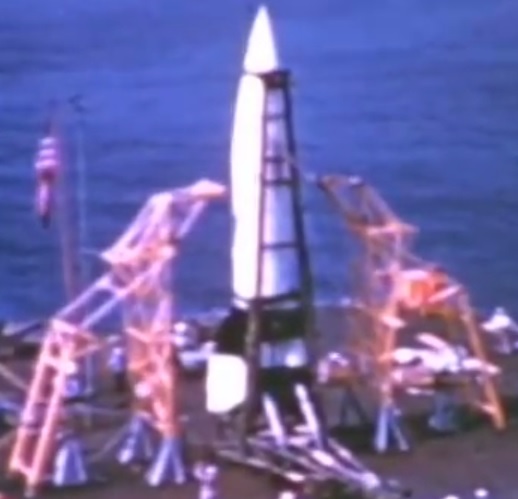
(The Bureau of Ordnance design being tested with the dummy V-2 aboard USS Midway.)
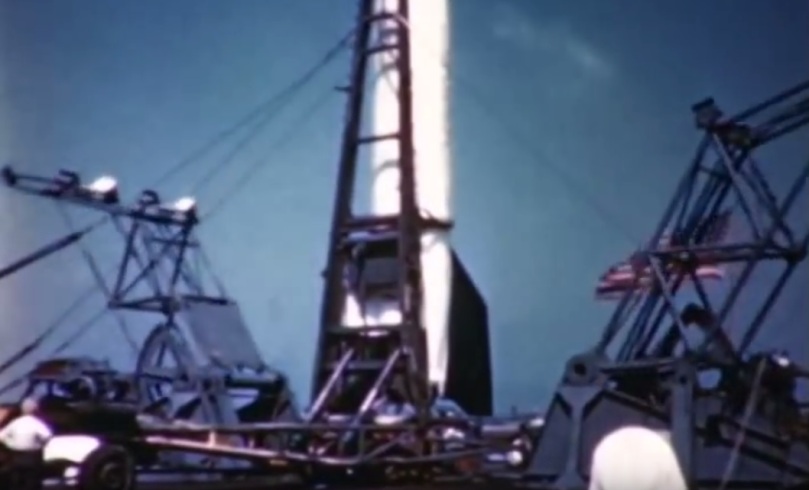
(The Bureau of Aeronautics design being tested aboard USS Midway. This was the version selected for operation “Sandy”.)
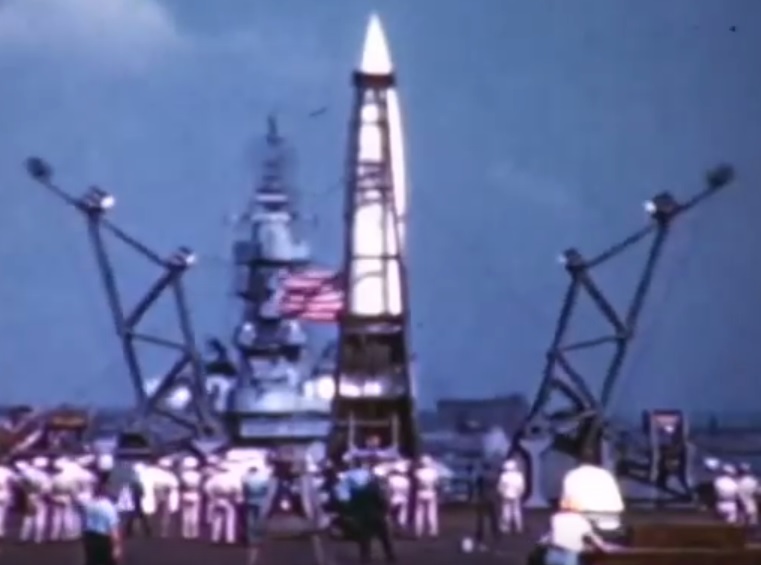
(USS Midway’s crew practice with the launch gantry while pierside in Norfolk. A WWII battleship is in the background.)
While USS Midway was still moored at Norfolk, the carrier’s damage control teams practiced all eventualities of what might possibly go wrong. Based on interviews with German personnel secured during the “Paperclip” operation, it was felt that the worst case scenario was what was termed “IFTC” (Ignition with Failure-To-Clear) when the V-2’s engines would successfully start but, for whatever reason, the missile would not generate sufficient thrust to take off, thumping back down onto the launcher and exploding. The Germans said that this happened numerous times during WWII, usually with negative results to nearby structures or personnel.
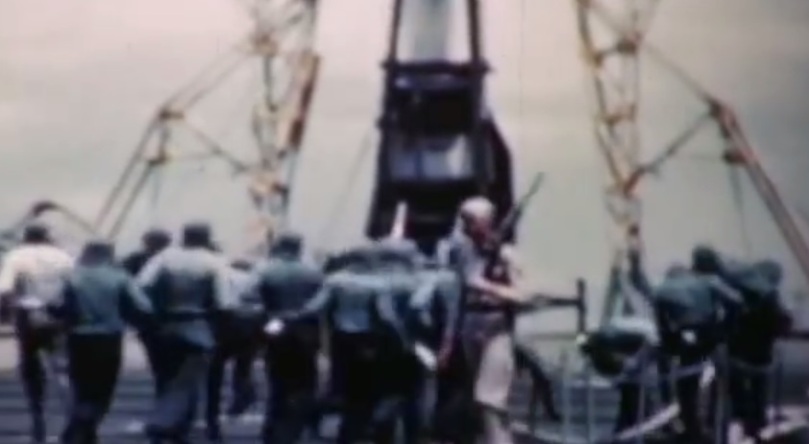
(A damage control team drills aboard USS Midway in Norfolk prior to the “Sandy” task force getting underway. The sailors are wearing antiflash hoods, as the greatest expected danger was a LOX-fed fire of brief duration but very intense heat. In front of them, a watchstander patrols with a M1903 Springfield, which was still very much in US Navy use in 1947.)
The B-Stoff propellant was pumped into one of USS Midway‘s AVGAS (aviation fuel) tanks, diluted with freshwater. Prior to the actual launch, it was refined back to the necessary specification and pumped into a US Army-designed fuel trailer for movement on the flight deck.
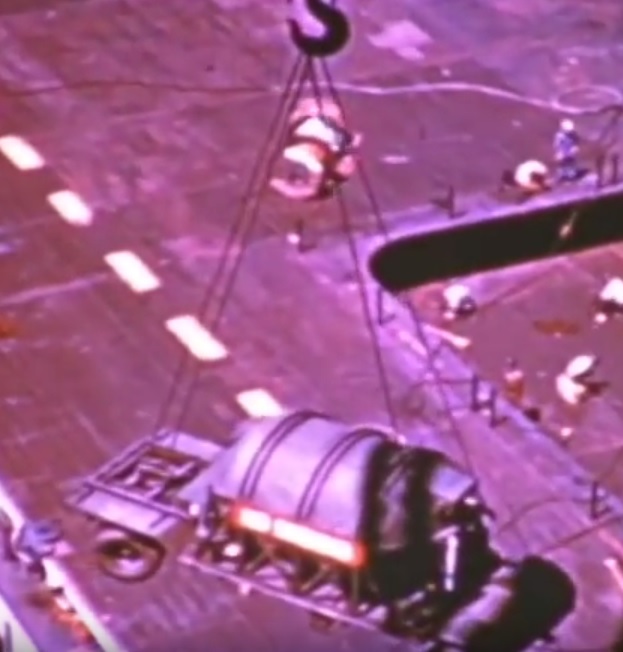
(The tank for the B-Stoff propellant, here empty, being loaded aboard USS Midway.)
The LOX oxidizer was considered the most hazardous item in operation “Sandy”. Three large spherical tanks, mounted onto flatbed trailers, carried the LOX. To minimize danger to the ship, these three tanks were the last items taken aboard immediately before USS Midway departed Norfolk.
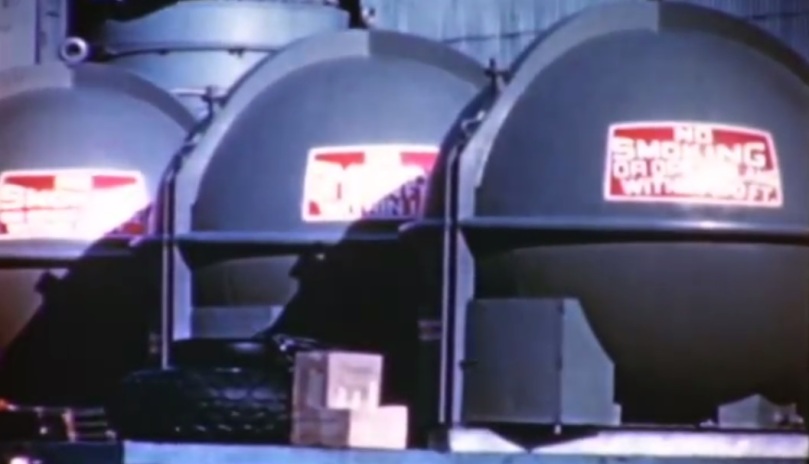
(The three LOX storage spheres on the pier in Norfolk. They were the last items to be taken aboard USS Midway.)
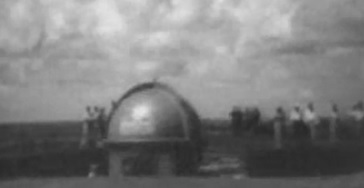
(One of the spheres being lowered into USS Midway’s hangar deck.)
The temporary “Sandy” flotilla was designated TG41.16, directly subordinate to the Atlantic Fleet and commanded by a rear admiral. Besides USS Midway, TG41.16 consisted of the destroyers USS Goodrich (DD-831), USS Everett F. Larson (DD-830), USS Lloyd Thomas (DD-764), and USS Hanson (DD-832). USS Goodrich and USS Hanson were themselves WWII-veteran warships. There was obviously no military threat to the US Navy in 1947 and the destroyers were attached to test methods of shipboard tracking of ballistic missiles in flight, and to ensure no civilian shipping was endangered by the test. Six shore-based PB-1W (the US Navy’s designation for the WWII B-17 Flying Fortress, modified with AN/APS-20 radar) planes were assigned to ensure the launch area and possible impact zone was clear of merchant shipping.
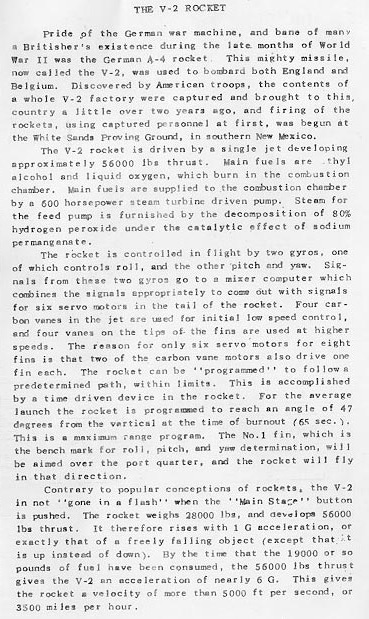
(A page from a booklet distributed to TG41.16 personnel explaining the characteristics of the V-2 ballistic missile.)
A variety of high-ranking personnel was present, including three admirals, two vice-admirals, three generals, the dean of Purdue University, and an executive from General Electric. Also present were observers from the Martin, Douglas, and Grumman aircraft companies which viewed naval ballistic missiles as a future opportunity.
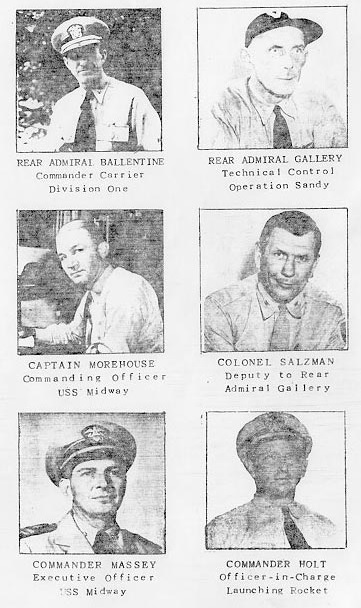
(Some of the key personnel of operation “Sandy”.)
The launch area was 250NM southeast of Bermuda. While enroute, USS Midway‘s crew used the dummy missile to practice handling and moving the V-2 and it’s fueling components. As the carrier moved closer to the launch area, technicians began diagnostic tests on the primary V-2 in USS Midway‘s hangar deck.

(USS Midway passing Bermuda, with the empty launch gantry circled.)
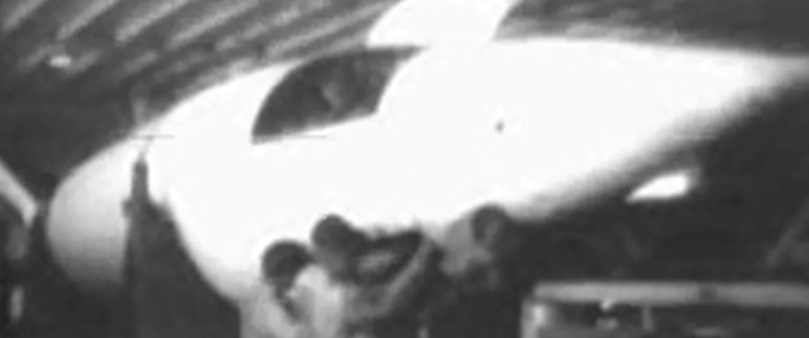
(Preliminary diagnostic checks being done on the primary V-2 inside USS Midway’s hangar deck.)
On 5 September 1947, the day before the scheduled test, USS Midway conducted a full dress rehearsal of the test with no problems.
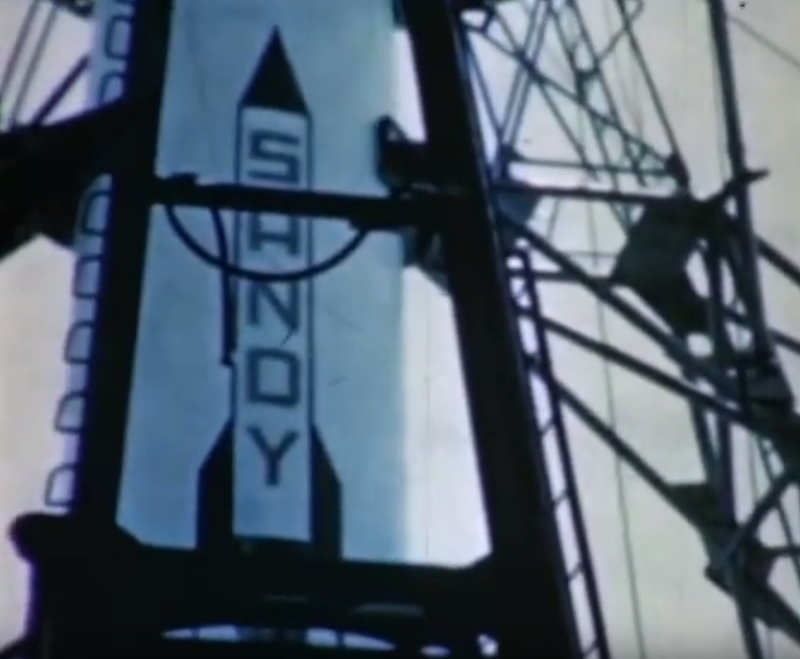
(After the dress rehearsal with the dummy missile, the actual primary V-2 was given a decorative paint scheme for the next day’s launch.)
The test firing
Before dawn on 6 September 1947, the crew of USS Midway brought the V-2 on deck, and by 06:00 local time it was erected in the launching gantry. The gyroscope and steering control system was given a final diagnostic, and a radar tracking beacon installed. The doppler radio transmitter on USS Midway‘s starboard aft quarter was also tested a final time. Finally the graphite exhaust vanes were installed on the V-2.

(The V-2 erected into the gantry, with personnel closing up the maintenance doors of the guidance section.)
Next, the fuel trailer was brought up via the aft elevator and about 4 tons of B-Stoff propellant was loaded into the V-2.
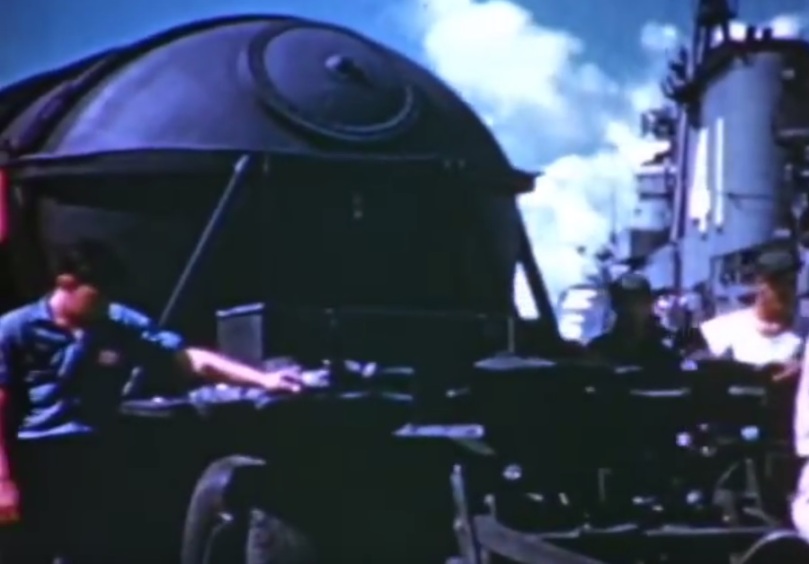
(The B-Stoff trailer is moved towards the missile.)
After the propellant was loaded, the three LOX spheres were brought up via the aft elevator and it was loaded into the V-2. During WWII, the Germans had used a special pumping truck based on the common Opel Blitz to load the LOX into V-2s. At sea aboard USS Midway in 1947, the carrier’s service steam system was modified so that it could be used to load the LOX at a constant 50-60psi.
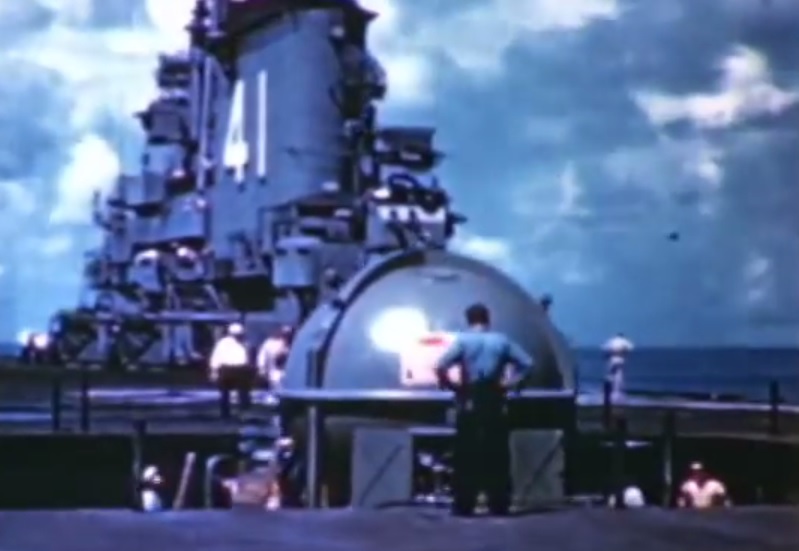
(One of the LOX spheres coming up USS Midway’s aft aircraft elevator.)
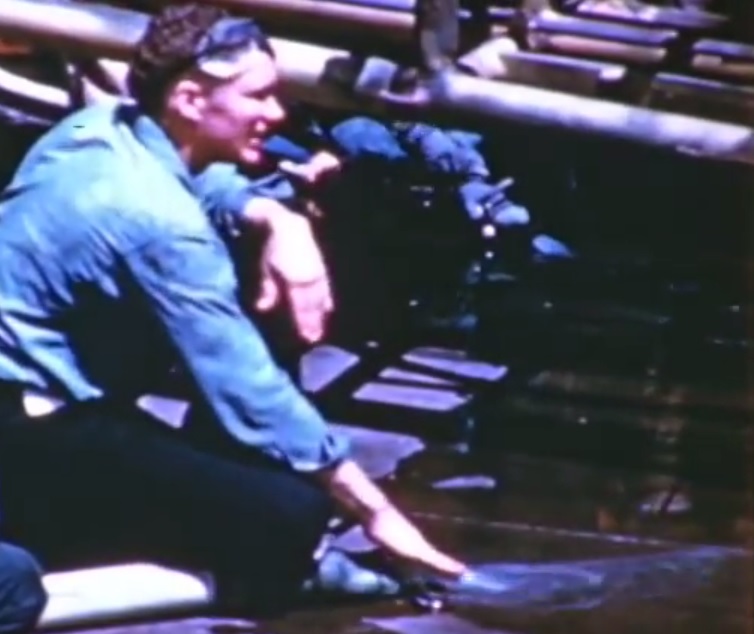
(As a safety precaution, fire hoses laid out a gentle stream of water in case any B-Stoff or LOX spilled onto the flight deck.)
The last item loaded into the V-2 was the hydrogen peroxide. Aboard USS Midway it was stored in a pressure container about the size of a beer keg, and had to be sprayed with water while on deck to be kept cool. Finally, a 30lb box of sodium permanganate (the hydrogen peroxide’s catalyst) was inserted into the V-2. With this step complete, and the V-2 secure and erected inside the gantry, the missile was ready for firing.
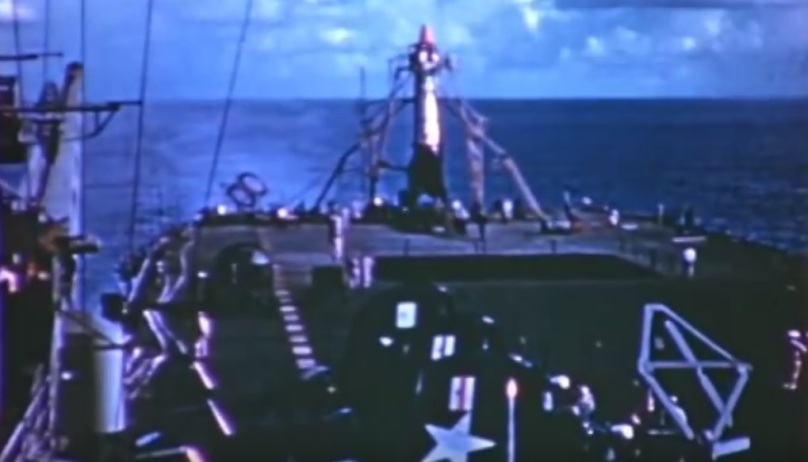
(The fully-fueled V-2 ready for launch.)
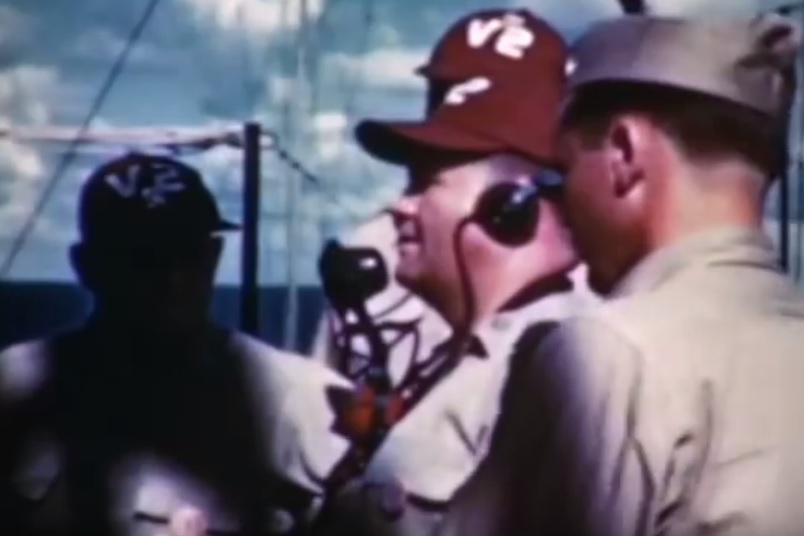
(Members of the V-2 team just prior to the launch.)
At T-1 minute, USS Midway‘s 1MC (intercom) signaled the start of the launch procedure. At T-22 seconds, the countdown started. At T-5 seconds, the rocket motor was ignited and the gantry arms dropped. At T-1 second, the main stage button was pushed and the V-2 took off.
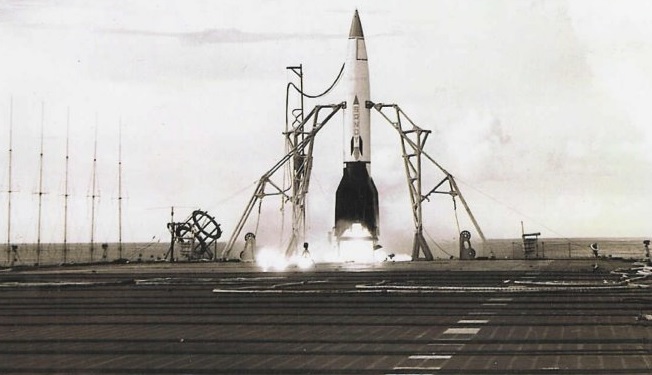
(Ignition of the V-2’s rocket engine, the moment before the gantry arms dropped clear. One of the radio-telemetry antennas is visible in the background.)
About one second after liftoff, just a few feet above USS Midway‘s flight deck, the V-2 tipped sharply to starboard about 43° off vertical. The V-2 ascended at this cockeyed angle for about 2¾ seconds, crossing the starboard edge of the flight deck and passing the height of the carrier’s island and radar masts, before sufficient airspeed was achieved at T+3 seconds for the fins to take over from the carbon vanes. At this point, the missile righted itself and continued it’s proper ascent. However, it appeared that the V-2 was “working hard” against the initial irregularity, and observers noted at least three see-saw maneuvers with the climbing V-2 rocking back and forth about 20° off it’s planned ascent axis; the guidance system seemingly struggling to keep up.
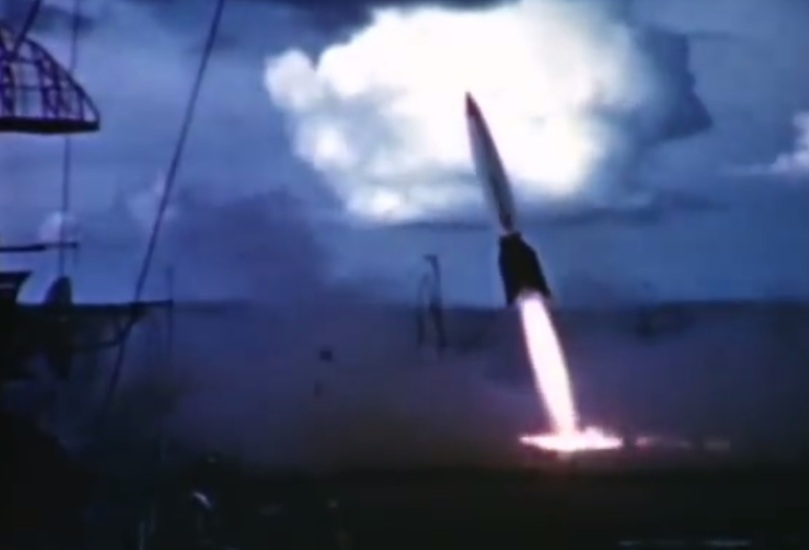
(The V-2 taking an unexpected angle.)
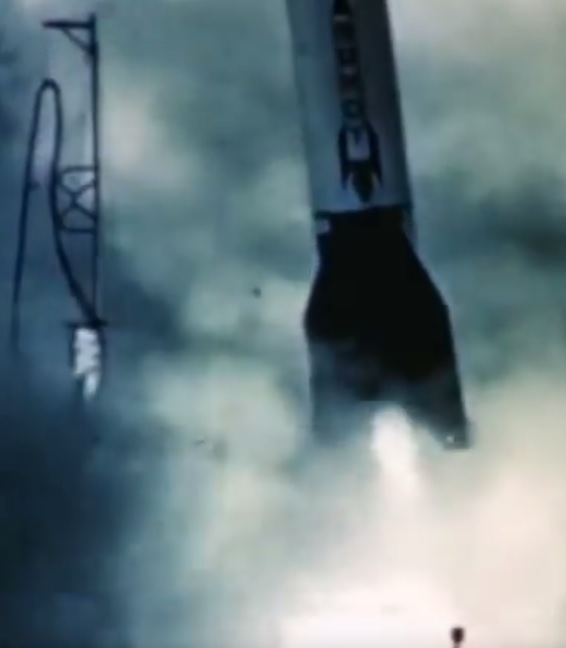
(The pitch beginning, about one second after launch.)
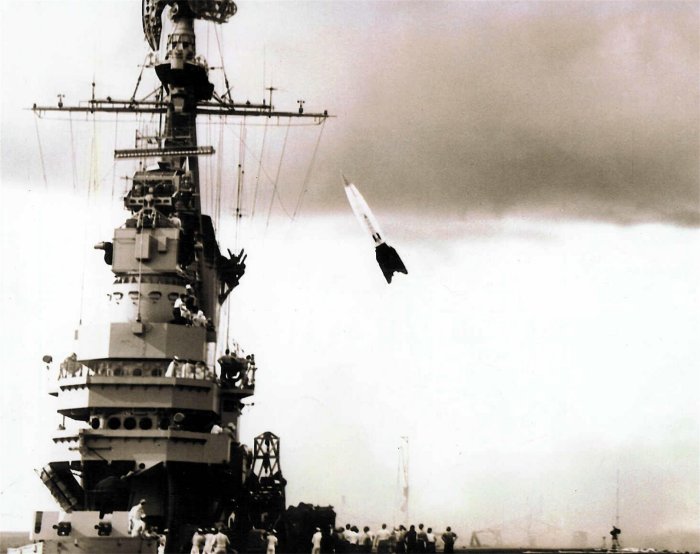
(The V-2 ascending at it’s majorly incorrect angle, here passing the height of USS Midway’s island.)
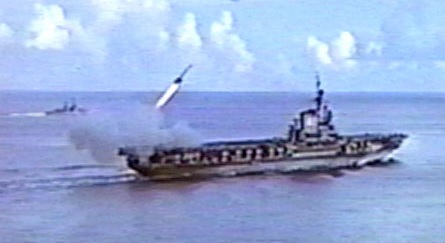
(Taken from a helicopter, this photo shows the V-2 at it’s severe pitch, just before the fins took over from the graphite vanes and corrected it temporarily.)
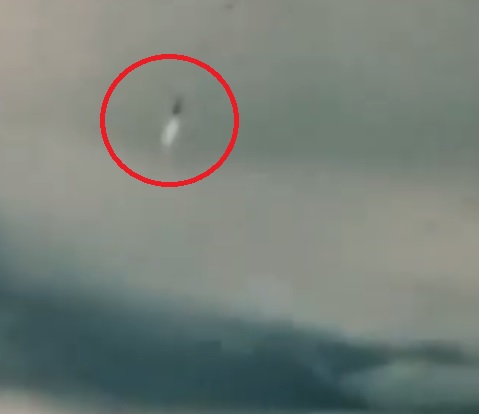
(The missile after it’s pitch was temporarily corrected, now several thousand feet in altitude.)
At about T+15 seconds and roughly 11,500′ altitude, the V-2 appeared to start shedding pieces, possibly being torn off it’s fuselage by aerodynamic forces as the unstable missile was still accelerating. At about 12,000′ altitude, the V-2 broke apart. Three large pieces of debris were tracked on the way down, crashing into the Atlantic ocean.
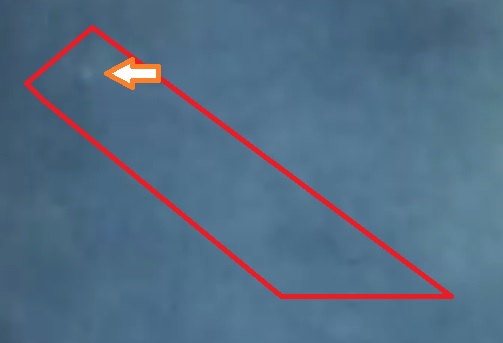
(As the WWII missile (orange arrow) passed 12,000′ it broke apart; small falling pieces can faintly be seen in the red box behind it.)
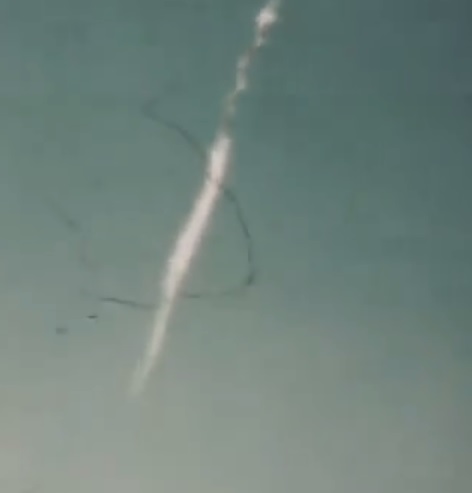
(A section of burning debris descending after the V-2 broke apart.)
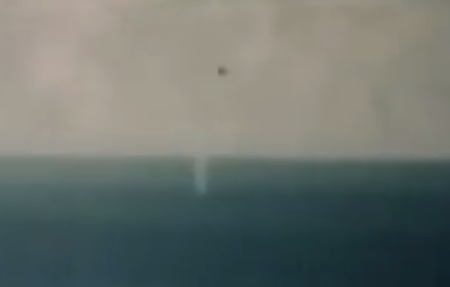
(A small piece of debris landed 5,700 yards off the starboard side of USS Midway. The splash is from the debris, the black spot is a flaw in the film.)
Part of operation “Sandy”s test criteria was a requirement for USS Midway to resume normal carrier operations in a reasonable amount of time. The US Navy wanted this as an indication that the missile firing was not a gimmick but rather a capability that could, in theory anyways, be adapted to real-world fleet combat. Immediately after the V-2 was away, sailors began disassembling and moving away the gantry components. Since the missile only used the extreme aft end of the flight deck, planes could have taken off at any time but peacetime regulations mandated a clear flight deck in case a plane had trouble after takeoff and needed to turn around and immediately land. At T+1 hour 10 minutes, a F4U Corsair fighter took off, signifying the successful conclusion of operation “Sandy”.
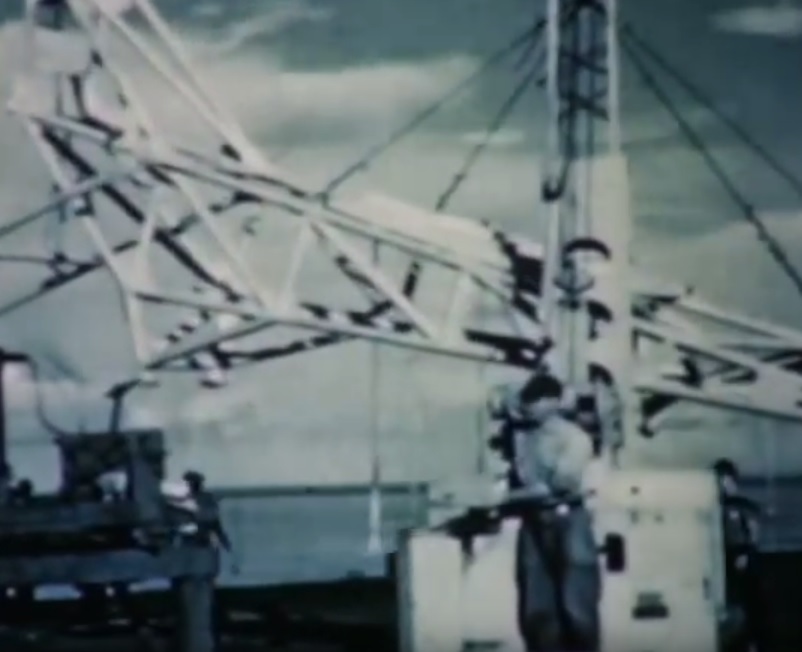
(USS Midway crewmen quickly disassemble the launch equipment on the aft end of the flight deck.)
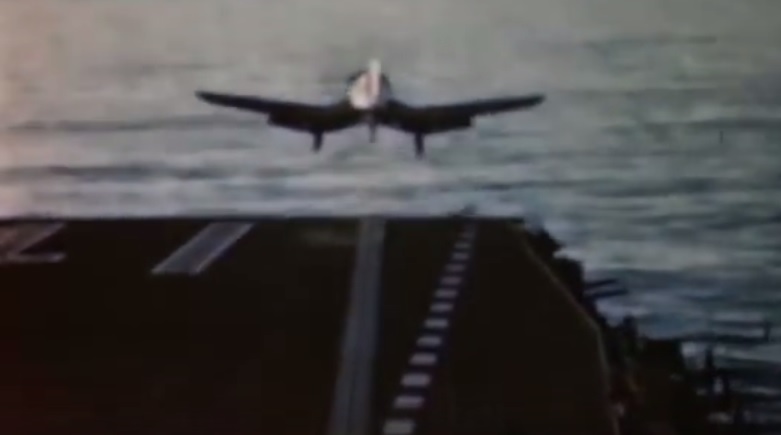
(A F4U Corsair fighter takes off seventy minutes after the V-2 had been fired.)
The US Navy graded operation “Sandy” as a full success, which, given the limited evaluation criteria, it was. The fact that the missile broke apart at 12,000′ was considered irrelevant as the operation was just to fuel a V-2 and get it into the air, not to have it successfully descend and hit a target. The turnaround to normal carrier operations was also a success, although in fairness it was with a rested peacetime crew which had rehearsed the event.
Some investigation was done as to why the V-2 flew erratically but with the technology of the time, no firm determination could be made.
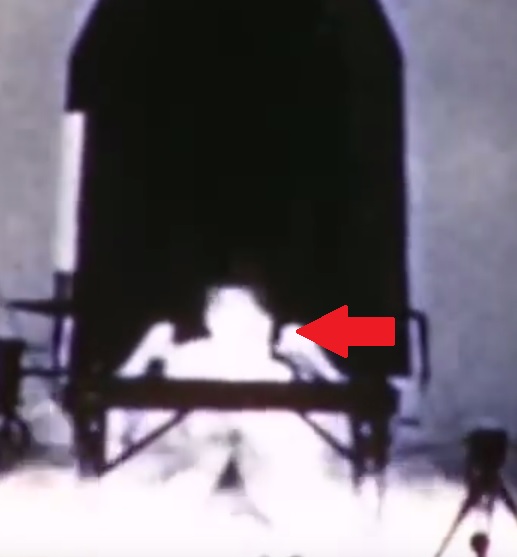
(The red arrow points to one of the graphite exhaust vanes (partially hidden by flame) which most of the team aboard USS Midway felt was responsible for the V-2 taking the unexpected severe side pitch. They felt it was possible that the vane had been installed incorrectly and somehow slipped passed all the checks and double-checks, or, that possibly the operation simply had the bad luck of getting a vane with a manufacturing flaw.)
Operation “Pushover”
While the V-2 firing was applauded as a success and was a source of pride for USS Midway‘s crew, sailors on deck recalled a split second of absolute terror as they watched the missile pitch sideways at takeoff. The US Navy was also concerned and decided to test the effects of what a botched launch would have been.
At the US Army’s White Sands, NM facility, a replica of a portion of a Midway-class flight deck was built in 1948. The US Navy used this to simulate a catastrophic accident during a liquid-fueled ballistic missile launch aboard an aircraft carrier. To simulate the accident, a V-2 modified with four special v-shaped “legs” would be made to hit the deck. Two of the four legs had explosive bolts which would sever the legs, causing the V-2 to topple over sideways.
Neither of the two V-2s used in “Pushover” had warheads. In late 1949, a preliminary pre-test was done. This was an unfueled, non-flightworthy V-2 fuselage to test the leg’s design and make sure it tipped over the right way. Test “Pushover-1” went as planned. For “Pushover-2”, the German missile was fully fueled. This test too went as planned. The V-2 toppled over and blew up on the facsimile flight deck.
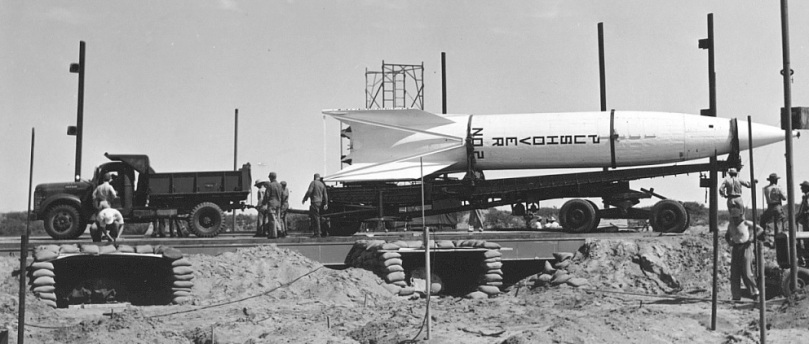
The results were appalling to the test team. A huge hole was punctured in the steel deck, and the steel plating in a large area was weakened, bent, and distorted from the heat. Had the explosion happened on a real Midway-class carrier, spilled propellant and burning oxygen would have ran into the hangar deck below, which, presumably, would be full of warplanes, bombs, and aviation fuel.
No further tests were done due to the USA’s dwindling stockpile of captured V-2s by 1949, and in any case no further evidence was needed. The US Navy decided that it was not going to take liquid-fueled ballistic missiles to sea. All of the US Navy’s Cold War ballistic missiles (Polaris, Poseidon, and Trident I) up to the UGM-133 Trident II of today, have all been solid-fueled.
The simulated flight deck was left in place and the hot, dry New Mexico climate preserved it. As of 2016 it remains abandoned.
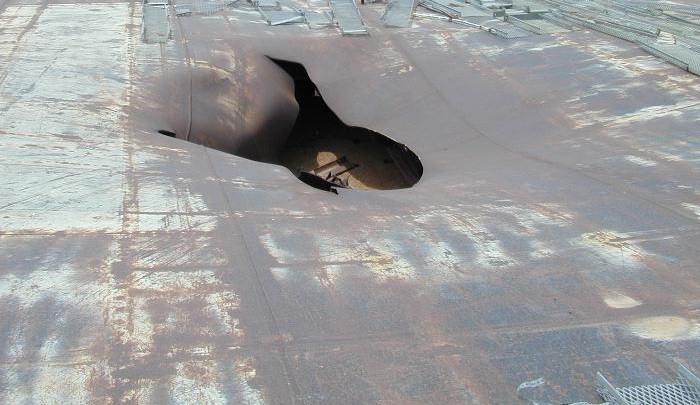
The legacy
No US Navy aircraft carrier ever took a ballistic missile to sea again. Early in the Cold War, ten WWII-veteran Essex class ships were briefly armed with one or two of the early Regulus cruise missiles. Generally speaking, the “brownshoe” community (naval aviators) frowned on aircraft carriers being equipped with anything not directly related to operating manned warplanes.
Several options were explored for taking ballistic missiles to sea after operation “Sandy”, using WWII surface combatants. The final Iowa-class battleship USS Kentucky (BB-66) had been suspended after the end of WWII, then briefly restarted, then suspended again in August 1946 with the battleship launched and about 60% complete. In September 1946 a whole variety of ideas were floated after WWII as what to do with the expensive half-built USS Kentucky. These included replacing some or all of the 16″ turrets with SAM launchers, fitting Regulus cruise missiles, or fitting a yet-to-be-developed ballistic missile.
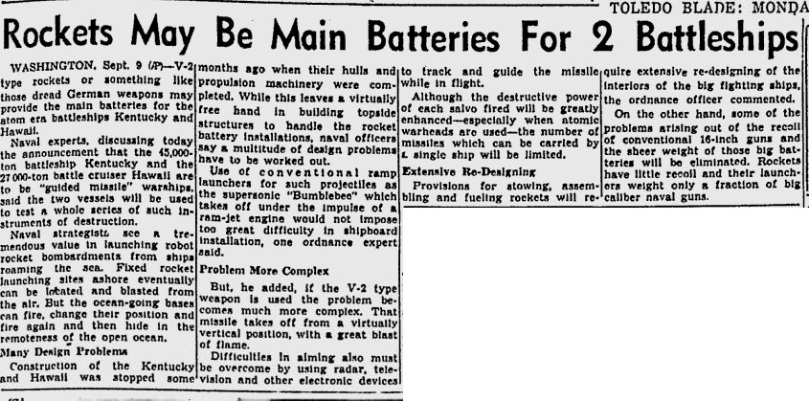
(Clipping from the 9 September 1946 issue of the Toledo Blade newspaper, describing the US Navy’s possible installation of ballistic missiles.)
After the 1947 “Sandy” test, the US Navy abandoned any plans for any V-2-style, liquid-fueled missiles. In August 1948, work resumed on USS Kentucky, to be completed as a standard Iowa configuration while a final decision was made. Work was later again halted. In 1956, it was proposed to fit the solid-fueled UGM-27 Polaris, then still under development, to the incomplete USS Kentucky; now 76% complete. However that year, the bow of USS Kentucky was cut off and grafted onto her sister USS Wisconsin (BB-64) after an accident. USS Kentucky was discarded in 1958, never having been completed.

(USS Kentucky in 1950.) (photo via navsource.org website)
The Alaska-class battlecruiser USS Hawaii (CB-3) was 83% complete when work was suspended after the end of WWII. In 1946 it was proposed to use the hull as a ballistic missile ship either along with, or as a less expensive alternative to, USS Kentucky. Nothing was ever done and the incomplete USS Hawaii was scrapped in 1959.
In the mid-1950s, the advantages of combining a stealthy submerged atomic-powered submarine, with a solid-fuel ballistic missile, and a powerful nuclear warhead; were obvious. The notion of fitting ICBMs to surface ships faded. The keel of the submarine USS George Washington (SSBN-598) was laid in 1958 and in 1960 the UGM-27 Polaris was ready to arm it.
There was one last thought given to carrying ballistic missiles on surface ships. The all-missile atomic cruiser USS Long Beach (CGN-9) was originally intended to carry four ICBMs. Just before the cruiser’s completion, President Kennedy voiced concern over completely abandoning guns and some 3″ AA guns were instead mounted in the space intended for the ballistic missiles. No US Navy surface ship since then has ever been considered as a ballistic missile mount and barring something unforeseen, none ever will.
Operation “Sandy” was a crucial step towards developing the modern submarine based nuclear missile deterrence force of the USA. Many of the lessons learned were incorporated into later projects.
Rear Admiral Gallery continued on duty after the success of operation “Sandy”. In 1949, he wrote a series of editorials in civilian newspapers critical of how the US Navy was being managed. Probably because of his WWII exploits with U-505, he was not court-martialed for insubordination but was never promoted again. He retired in 1960.
USS Midway continued in service until April 1992. It is now a museum ship in San Diego, CA. The flight deck was remodeled and replaced during the carrier’s long service and the spot of the “Sandy” V-2 firing is not marked.

I never knew that about the V2. Incredible research you have done there it certainly was a game changer and led the way in missile technology.
LikeLike
[…] Source: Firing a V-2 off an aircraft carrier […]
LikeLike
If you have never read Dan Gallery’s books — one about the U505 and one more or less fictional called “Now Hear This” you should. The latter is absolutely hilarious.
LikeLiked by 1 person
Reblogged this on Lest We Forget II and commented:
Very interesting
LikeLike
A unique piece of history, thank you for sharing.
LikeLiked by 1 person
Good morning,
Pen and Sword Books is the UK’s leading Military publishers and I was wondering if you would be interested in becoming a reviewer of some of our transport/tank/military vehicle/warfare titles? Please take a look at our website, if you’re unfamiliar with our company, to get an idea of some of the titles we publish. http://www.pen-and-sword.co.uk/search/products/tanks
If you’d like to discuss this opportunity further, please email me at digitalmarketing@pen-and-sword.co.uk.
I look forward to hearing from you,
Milly Wonford
Digital Marketing Executive
Pen & Sword Books
LikeLike
Yes I am interested but the email bounces back?
LikeLike
Very interesting.
I served on USS Midway (CV-41) from 1986 to 1989, and this was referred to in the official ship’s official history, but probably less than a single sentence.
So thank you for this.
LikeLiked by 1 person
yes i was on the midway when we fire the v 2 what a day we had one of the best crew all work to gether
LikeLiked by 1 person
There was never a ‘USS’ Kentucky, she was never commissioned by the US Navy. Thus, just the Kentucky.
LikeLike
I have a little related story.
The USN wasn’t the only one to experiment with ship launched missiles. The Italian Navy wanted a deterrence capability, in addition to the Jupiter missiles deployed by the US in Puglia.
To this end the rebuild of the WWII vintage light cruiser Giuseppe Garibaldi, in 1957, included the installation of 4 launch tubes for Polaris missiles, to be supplied by the US.
After the Cuban Missile Crisis the US retreated from the accord, and Italy set out to develop its own version of the Polaris, named Alfa, and an homegrown nuclear program (believe it or not, it was the last NATO member to sign the non-proliferation treaty in 1975, because, of all the reasons, Switzerland was pursuing the nuclear bomb too).
In the end that ended up nowhere and the ship never carried a missile, but they did ejection tests with Polaris and Alfa mockups.
Tought you might find that interesting! (and maybe an idea for a future article, who knows…)
LikeLiked by 1 person